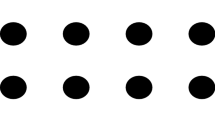Abstract
Justin D’Ambrosio and I have recently and independently defended perceptual adverbialism from Frank Jackson’s well-known Many-Properties Problem. Both of us make use of a similar strategy: characterizing ways of perceiving by using the language of objects, and not just of properties. But while D’Ambrosio’s view does indeed validate the inferences that Jackson’s challenge highlights, it does so at the price of validating additional, invalid inferences, such as the inference from the claim that a small child hallucinates a bottle of aspirin to the claim that the child hallucinates a bottle of acetylsalicylic acid. My view avoids this. The crucial difference is that D’Ambrosio appeals to success conditions, which are extensional, while I appeal to informational content, which is not.
Similar content being viewed by others
Notes
Almost needless to say, it did not disappear completely. Before his conversion to representationalism, Michael Tye was a prominent advocate. See Tye (1984).
Since (1) is about hallucination, we should, to be fully explicit, add the phrase ‘although there is nothing before his eyes that appropriately explains his sensing’. For simplicity I will omit such qualifications.
This is Wilfrid Sellars’ (1975) suggestion, in his response to Jackson.
The double brackets here indicate that what is doing the characterizing of e is a generalized quantifier: the semantic value of a quantified noun phrase like ‘a red square’, ‘six wild horses’ or ‘the fountain of youth’. The distinction between a dagger and [[a dagger]] plays no role in the argument of this paper, however. So, for purposes of simplicity, I will sometimes replace talk of [[x]] with talk of x.
This is a generalization from the specific instance D’Ambrosio (2019, p. 429) uses; I’ve replaced D’Ambrosio’s ‘a dragon’ with the more general and boring ‘x’.
D’Ambrosio (2019, p. 426). D’Ambrosio (2021) is an extended argument that his form of adverbialism, as well as what he calls ‘property’ views of perceptual experience, can validate upward monotonicity quite generally. This might seem to suggest that D’Ambrosio regards this validation as unqualifiedly desirable, but see D’Ambrosio (2021, n. 34) for an acknowledgement that some qualifications are required.
D’Ambrosio (2019, p. 427). Here ‘Q’ and ‘Q′’ are quantified noun phrases of the sort mentioned above in note 6. I’ve replaced D’Ambrosio’s ‘search’ and ‘find’ with ‘perception’ and ‘see’.
In particular, while sensing is intensional in that it neither involves existential commitment nor permits substitution of coreferential expressions, believing also allows “unspecific” readings such as ‘he believes two people committed the robbery’ (because of the manner of entrance). Visually sensing two people, on the other hand, seems to require sensing two specific people. I am glossing over another difference; that sensing is directed at an object, while believing is directed at a proposition. My main point is simply that intensionality is not a monolithic concept, but names a range of phenomena.
At least, this claim will be endorsed by anyone sympathetic to a non-relational view such as adverbialism. Adverbialists are committed to the idea that it is possible for someone who is causally completely isolated from the Penn Museum's crystal sphere—and who could therefore not hallucinate it—to have a visual experience of precisely the same kind as someone who was actually seeing it, or as someone who was hallucinating it.
Gert (2020, p. 8). This can seem very similar to representational content. But, as I argue, informational content can be understood in terms of conditional probabilities.
‘Signal’ here just means ‘something from which we can extract information’: tire tracks, blood-splash patterns, radiation from distant galaxies, tree rings, as well as conscious sensory experiences.
For a view of information that makes both of these relativizations explicit, see Scarantino (2015). On his account, the informational content of a signal L with respect to a set of states (S1, S2,…, Sn) and background data d, is given by a set of the following sorts of claims, where i ranges from 1 to n:
Ci: Si is incrementally supported to degree log[p(Si | (L & d)) / p(Si | d)] and overall supported to degree p(Si | (L & d)).
Here p(x) is the probability of x, and p(x | y) is the probability of x, given y. Incremental support is a matter of changes to the probability of a state.
References
D’Ambrosio, J. (2019). A new perceptual adverbialism. The Journal of Philosophy, 116(8), 413–446.
D’Ambrosio, J. (2021). The many-property problem is your problem, too. Philosophical Studies, 178, 811–832.
Forbes, G. (2006). Attitude problems. Oxford University Press.
Gert, J. (2020). Information-theoretic adverbialism. Australasian Journal of Philosophy, Advance Online Publication. https://doi.org/10.1080/00048402.2020.1809477
Jackson, F. (1975). On the adverbial analysis of visual experience. Metaphilosophy, 6(2), 127–135.
Millikan, R. (2013). Natural information, intentional signs and animal communication. In U. Stegmann (Ed.), Animal communication theory: Information and influence (pp. 133–148). Cambridge University Press.
Scarantino, A. (2015). Information as a probabilistic difference maker. Australasian Journal of Philosophy, 93(3), 419–443.
Sellars, W. (1975). The adverbial theory of the objects of sensation. Metaphilosophy, 6(2), 144–160.
Stegmann, U. (2015). Prospects for probabilistic theories of information. Erkenntnis, 80, 869–893.
Tye, M. (1984). Adverbialism. The Philosophical Review, 93(2), 195–225.
Acknowledgements
Thanks to Justin D’Ambrosio, Jonah Goldwater, Elizabeth Radcliffe, Philip Swenson, and Chris Tucker.
Author information
Authors and Affiliations
Corresponding author
Additional information
Publisher's Note
Springer Nature remains neutral with regard to jurisdictional claims in published maps and institutional affiliations.
Rights and permissions
About this article
Cite this article
Gert, J. Adverbialism and objects. Philos Stud 179, 699–710 (2022). https://doi.org/10.1007/s11098-021-01677-2
Accepted:
Published:
Issue Date:
DOI: https://doi.org/10.1007/s11098-021-01677-2




